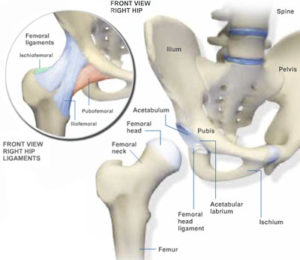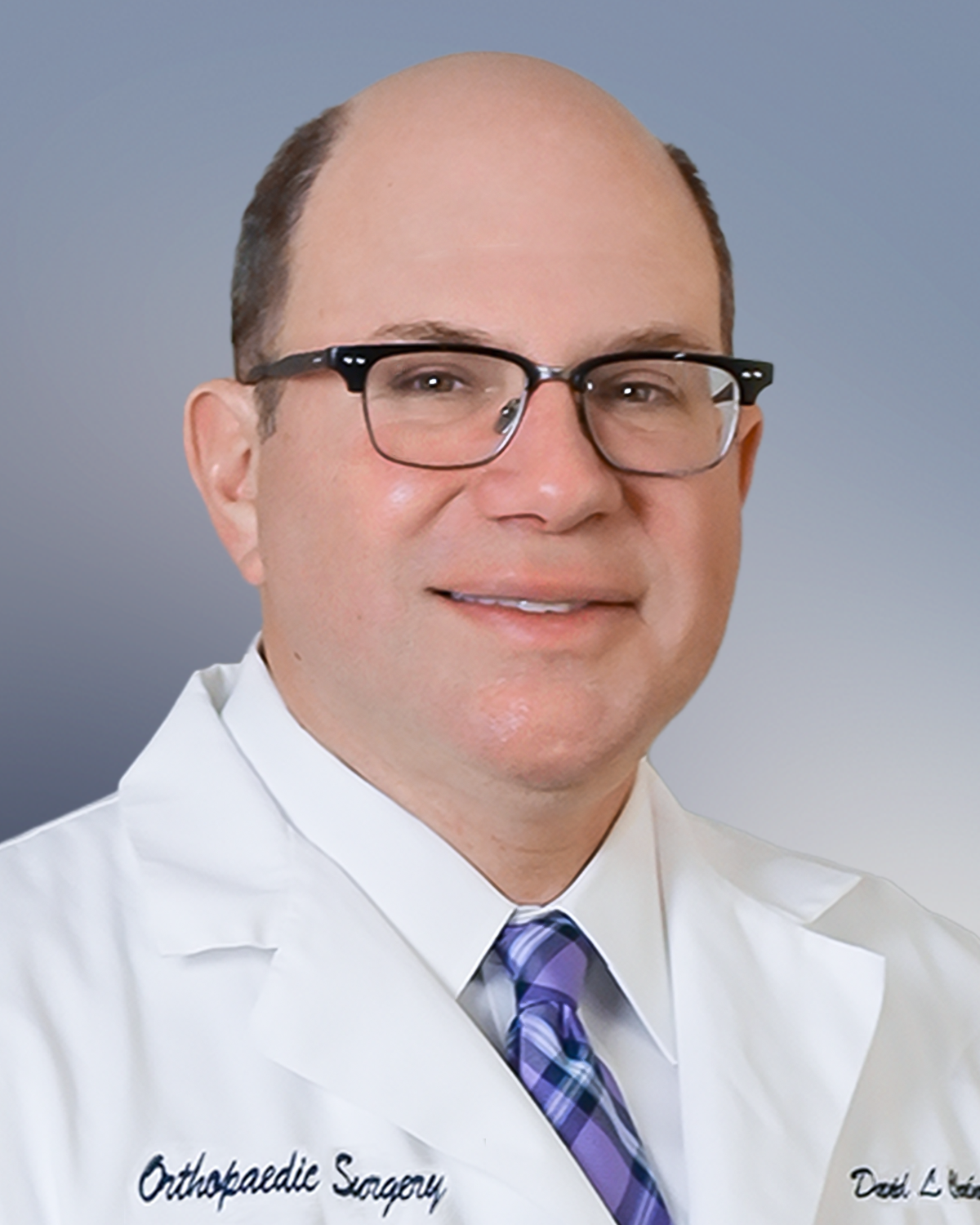Hip Orthopedics: Doctors, Conditions & Treatments
 Anatomy of the Hip
Anatomy of the Hip
The hip joint is located where the thigh bone (femur) meets the pelvic bone. It is a “ball and socket” joint. The upper end of the femur is formed into a round ball (the “head” of the femur). A cavity in the pelvic bone forms the socket (acetabulum). The ball is normally held in the socket by very powerful ligaments that form a complete sleeve around the joint (the joint capsule). The capsule has a delicate lining (the synovium).
The head of the femur is covered with a layer of smooth cartilage which is a fairly soft, white substance about 1/8 inch thick. The socket is also lined with cartilage (also about 1/8 inch thick). The cartilage cushions the joint, and allows the bones to move on each other with very little friction. An x-ray of the hip joint usually shows a “space” between the ball and the socket because the cartilage does not show up on x-rays. In the normal hip this “joint space” is approximately 1/4 inch wide and fairly even in outline.
Meet Our Orthopedic Hip Surgeons
Our orthopedic hip doctors at Seaview Orthopaedics are your trusted institute for hip orthopedics, hip injuries, and hip pain. Our orthopedic hip specialists are committed to providing high-quality specialized hip treatments for our patients.
Symptoms of Hip Disease
The most prominent symptom of hip arthritis is pain. Most patients think that their hip is in the region of the buttocks and are surprised to learn that true hip pain is most commonly experienced in the groin. Groin pain of hip arthritis is sometimes misdiagnosed at first as a hernia or a “groin pull. The pain can radiate down the front of the thigh for a few inches as well. Occasionally, it goes all the way down the thigh to the knee (“referred pain”). This is because the hip and knee have an overlapping nerve supply. In fact, in some patients with hip disease, knee pain may be the only symptom!
Back pain is even more frequently confused with hip pain. Pain in the buttocks, across the low back, and down the back of the thigh, usually comes from the spine. It usually indicates a pinched nerve in the lower spine. Patients with a pinched nerve will also often have numbness or tingling in the leg.
To complicate matters, some patients with an arthritic hip may also have a pinched nerve from a back disorder. It is important in such cases to determine which problem is causing most of the pain: the hip or the back. If your problem is mainly in your back, you may still be left with most of your pain after going through a hip replacement, and you will not be very happy with the result! If the most prevalent symptom is hip pain, a hip replacement may have the added benefit of improving your back condition as well, since the stiffness of an arthritic hip can aggravate a back problem.
Signs of Significant Hip Disease
Most patients with significant hip disease have a limp and one leg may feel shorter than the other. Bone-on-bone contact occasionally causes the patient to feel or hear the hip creaking during walking. As the disease progresses, the hip becomes stiff and less movement is possible. This may make it difficult for you to clip your toenails or to tie your shoelaces, and may also limit your ability to spread your legs.
Quite often the first step or two after prolonged sitting may be especially painful. Eventually you may have to “take a break” to ease the pain after walking only short distances. The distance you can walk will gradually decrease until you can only take one or two steps at a time.
3 Common Causes of Hip Pain
The three common causes of pain around the hip are arthritis, bursitis, or a pinched nerve in the lower back (the most common cause). The groin pain of hip arthritis is sometimes misdiagnosed at first as a hernia.
Hip Surgical Procedures
The orthopedic hip surgeons at Seaview Orthopaedics are experts in various hip surgeries, including hip arthroscopy, hip replacement, and hip revision surgery.
Hip arthroscopy is a surgical procedure that can be used to treat several common hip injuries, including femoroacetabular impingement, labral tears, dysplasia, and snapping hip syndrome. Arthroscopy is less invasive than open surgery, often leading to quicker recovery times. Dr. Kenneth Chern trained under one of the founding fathers of hip arthroscopy and is one of the leading surgeons in hip arthroscopy in Monmouth and Ocean counties.
Hip replacement surgery may be an option for you if arthritis pain has limited your mobility and your pain has not improved with nonsurgical treatment options. At Seaview, our board-certified orthopedic surgeons perform hip replacements on a weekly basis, if not more often.
If you have had a hip replacement and have experienced problems with it, you may be a candidate for hip revision surgery. Initial hip replacements are very successful for the vast majority of patients and provide lasting pain relief for many years. However, some patients may need a second hip replacement procedure due to infection, implant wear, or injury.
Nonsurgical Hip Treatment FAQs
The hip surgeons at Seaview Orthopaedics have answered some common questions and techniques to treat hip injuries without surgery.
If you have hip arthritis, the more you walk, the more the hip will hurt. In time, running, tennis, golf and eventually even walking may become impossible. You can minimize the pain by simply cutting back on activities which seem to aggravate the hip. Whenever possible, use an elevator (or an escalator) instead of stairs, and avoid long walks that leave you in pain. However, “saving the joint” by becoming totally sedentary will not slow down the arthritis. Therefore, it is recommended that you remain as active as your pain will comfortably allow.
A reported study in the Annals of Internal Medicine in 1992 suggests that people with hip arthritis who force themselves to remain active may do better in the long run than those who “baby” themselves. Also, being totally sedentary leads to a loss of muscle and bone strength.
The best all-around exercise for you is swimming. The water relieves the stress on your hip as you “walk” about in the shallow end of the pool. Your orthopedic doctor can prescribe a program of “pool therapy” for you. Bicycling (stationary or mobile) is also well tolerated. If you do not have access to an exercise bike or pool, then walk as much as you can tolerate without causing yourself excessive pain.
A cane has been known since pre-biblical times to be an effective pain-reliever for hip arthritis. Unfortunately most people today are too vain to use one! Two important facts about canes:
- Hold the cane in the opposite hand (yes, the opposite hand) from the side with the hip problem.
- The cane should be the correct height. Any medical supply company that sells you a cane will adjust it to the correct length.
Weight loss will probably decrease your pain if you are greatly overweight.
One pound of weight loss equals 3 pounds in stress reduction on the hip during normal gait! But weight reduction alone is unlikely to relieve the pain completely. Obesity also makes the hip operation more difficult, and complications occur more frequently in overweight people. It can be very difficult to lose weight when you are not very active because of your hip pain. Do the best you can!
Cortisone injection into the hip joint can be very effective if the cortisone is injected accurately into the joint.
Cortisone injections quite frequently provide pain relief for 6 months or so. The hip joint is a deep joint, so a long needle must be used with x-ray guidance for the needle. It is therefore not often done as an office procedure. Cortisone occasionally gives remarkable results, with even up to a year of relief in quite severe arthritis. You never how well it will work until you actually try it. Bursitis of the hip (another common cause of “hip pain”) is easily (and effectively) treated with cortisone injections given in the office.
NSAIDs are a group of drugs that decrease the inflammation (pain and swelling) in arthritic joints. The pain relief from NSAIDs can be quite amazing. Although they are commonly referred to as “arthritis pills,” none of them will in any way influence the outcome of arthritis.
There are many NSAIDs available, and newer ones are constantly being brought onto the market. The “newest” one is not necessarily the most effective. Most people respond better to one NSAID than to another, and you may have to try several before the “right” one can be found for you. They all have potentially serious side effects and should only be taken under medical supervision. Most can only be obtained by prescription and are expensive. Common over-the-counter NSAIDs are ibuprofen.
Always take NSAIDs with food or antacids, or with a full glass of water to avoid stomach upset.
Schedule an Appointment with Our Seaview Orthopaedics Hip Surgeons in NJ
At Seaview Orthopaedic & Medical Associates, we have provided quality orthopedic care for over 30 years! Our patients’ total experience with our practice is our number one priority. If you have been suffering from any kind of hip pain, be sure to schedule an appointment with a hip specialist at one of our six orthopedic clinics throughout NJ. To learn more feel free to contact us online.






